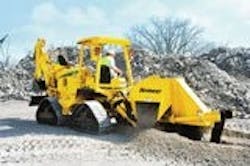When the RTX1250 was introduced in 2003, it rolled on tires. But Vermeer engineers decided to push the hydrostatically driven machine’s design envelope to keep it moving in ground conditions that jeopardize traction and flotation, especially when pulling a plow. An obvious way to accomplish this end was to use tracks instead of wheels, a design concept that Vermeer, working with ASV (now a Terex company), developed in 2006 for the RTX450.
The smaller RTX450 is successful riding on a pair of long, oval tracks with roller-cage sprockets engaging proprietary rubber belts. But twin tracks have some drawbacks that would be magnified on the larger tractor. Twin tracks would diminish the exceptional steering ability of the wheeled RTX1250, and its ability (via oscillating axles) to closely follow ground contours. The long, single track on each side of the machine would exhibit “break-over,” that is, the tractor would nose rapidly downward as the mid-point of its tracks crossed the apex of a hill or berm — disrupting the position of the towed attachment.
Vermeer worked with Loegering Mfg. (an ASV company) to develop a “quad-track” system, which can be used to replace each of the RTX1250’s wheels with a triangular track module. Each of the four modules uses a short track frame, a central sprocket, and a series of rubber-rimmed steel rollers that spread the weight of the tractor over the module’s rubber track. Of course, if the user considers the RTX1250’s wheels to be better for certain applications, then the track modules can be removed and the conventional undercarriage reinstalled by two competent technicians in an estimated 2.5 hours.
Compared with that of a wheeled RTX1250 equipped with a trencher and a backhoe, the ground pressure of a similarly equipped tractor on the quad-track system drops from 20.1 to 6.8 psi, even though substituting the track modules for the wheels increases the machine’s weight by nearly 4,600 pounds. The quad-track system lays down a larger, aggressive footprint at each corner, resulting in increased flotation and traction in soft or wet soils. But the rubber tracks are less damaging to finished landscaping, won’t damage pavement, and maintain most of the wheels’ transport speed.
Plus, says Vermeer, the rubber-track modules’ turning radius is virtually the same for both configurations. Steering modes are identical (although the current RTX1250 has a new fuel tank and other modifications to accommodate the rear-steering tracks). Front and rear axles still oscillate and use differential locks. And each track module can rotate on its hub, oscillating fore and aft, to help keep the track in contact with changing terrain. (A patented feature bolted to the end of the axle prevents the module from rotating beyond practical limits.)
The wheeled RTX1250, however, does accommodate more rear attachments than its tracked counterpart. Both can handle a standard trencher, plow and rockwheel, but the wheeled machine also can use a “combo” (a combination trencher/plow), a sliding offset trencher, sliding offset conveyor trencher and a sliding offset rockwheel.
The quad-track system has made a significant number of converts in its year or so of availability. Some customers pointed out, however, that severe applications, such as running in fractured limestone, would soon destroy rubber tracks. Cross-country plowing in these tough conditions require a more durable track.
In response, Vermeer and Loegering again went to work, developing a steel quad-track system that uses modules that reflect crawler-dozer undercarriage design. The steel-track modules use a heavy track frame, conventional track rollers, conventional chain (with links, pins and bushings) and steel shoes (19.5 inches wide) with aggressive grousers. The XTS1250, as Vermeer calls the tractor sold with its steel-track modules, weighs about 8,600 pounds more than the RTX1250 on wheels.
Like the rubber tracks, the steel-track modules behave like wheels beneath the XTS1250. But because the steel undercarriage sits higher than the wheeled and rubber-track versions, special rear attachments must be used. They accommodate the tractor’s higher profile and greater pulling power, which is some 30 percent more than the rubber-tracked machine.
